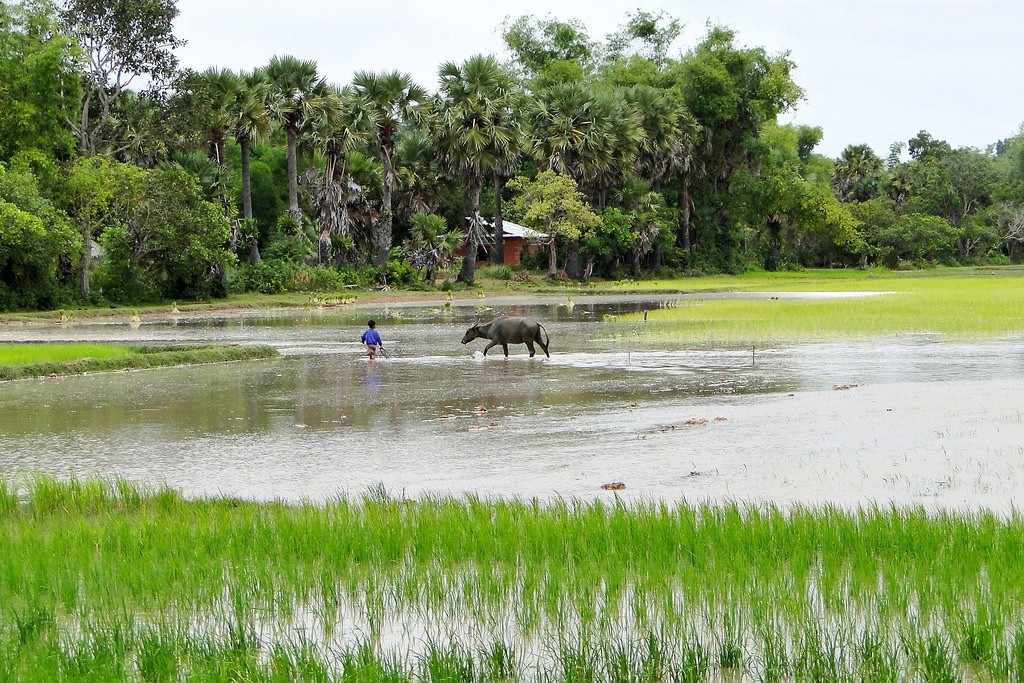
វាលស្រែនៅជនបទនៃប្រទេសកម្ពុជា។ រូបភាព ថតដោយ fmpgoh, កាលពីថ្ងៃទី ១៥ ខែកក្កដា ឆ្នាំ២០០៩។ អាជ្ញាប័ណ្ណ CC BY-NC-ND 2.0
ផលិតផលកសិកម្មបានចូលរួមចំណែក ៣៥% នៃផលិតផលក្នុងស្រុកសរុប និង៥៦%នៃការផ្តល់ការងារក្នុងទីផ្សារការងារសរុប។1 ផលិតផលចំបងក្នុងវិស័យនេះរួមមាន ស្រូវអង្ករ កៅស៊ូ ពោត បន្លែ គ្រាប់ស្វាយចន្ទី និងដំឡូងមី។ ការនាំចេញផលិតផលកសិកម្មមិនទាន់កែច្នៃ ត្រូវបានប៉ាន់ប្រមាណថាមានចំនួន៩០%នៃការនាំចេញផលិតផលកសិកម្មសរុបក្នុងឆ្នាំ២០១៥។ 2
ផលិតកម្មកសិកម្មមានកំណើន ៨.៧% ក្នុងចន្លោះឆ្នាំ២០០៤ និងឆ្នាំ២០១២ ដោយសារការកើនឡើងនៃផលិតកម្មគ្រាប់ធនជាតិ ដែលភាគច្រើនកើនចេញមកពីផលិតកម្មស្រូវអង្ករ (កំណើនប្រចាំឆ្នាំ៩%) ពោត (២០%) ដំឡូងមី (៥១%) អំពៅ (២២%) និងបន្លែ (១០%)។ កំណើននេះបានថមថយគួរឱ្យកត់សម្គាល់នៅឆ្នាំបន្តបន្ទាប់ទៀត។3
កំណើនទិន្នផលជាមធ្យមលើកសិផលគ្រប់ប្រភេទក្នុងចន្លោះឆ្នាំ២០០៤-២០១៤ មានប្រមាណ៤ %។ នេះជាលទ្ធផលនៃការ ទទួលយកបច្ចេកទេសដាំដុះកាន់តែប្រសើរ កំណើនប្រព័ន្ធធារាសាស្ត្រ និង ការទទួលបានកាន់តែប្រសើរនៃសេវាកម្មគ្រឿងចក្រ។4 ទាំងនេះគ្រាន់តែជាចំណុចចាប់ផ្តើមនៅឡើយ។ ការសិក្សារបស់ធនាគារអភិវឌ្ឍអាស៊ី(ADB) ស្តីអំពីការលើកកម្ពស់ផលិតកម្ម និងការធ្វើពាណិជ្ជភាវូបនីយកម្មស្រូវអង្ករនៅកម្ពុជាបានរកឃើញថា ទិន្នផលស្រូវអង្ករជាមធ្យមរបស់ប្រទេសកម្ពុជានៅមានកម្រិតទាបនៅឡើយ បើធៀបជាមួយនឹងប្រទេសជិតខាងរបស់ខ្លួន។ តួយ៉ាង ទិន្នផលស្រូវអង្ករកម្ពុជាមានប្រមាណជាងពាក់កណ្តាលនៃទិន្នផលស្រូវអង្គរសម្រេចរបស់ប្រទេសវៀតណាមតែប៉ុណ្ណោះ។5
ប្រភព៖ ការបង្កើនផលិតកម្ម និងពាណិជ្ជកម្មអង្ករ នៅកម្ពុជា, ធនាគារអភិវឌ្ឍន៍អាស៊ី ឆ្នាំ២០១៤
សហគ្រាសក្នុងវិស័យនេះមានទំហំខុសៗគ្នាដោយរាប់បញ្ចូលពីសហគ្រាសជាលក្ខណៈឧស្សាហកម្មរហូតដល់សហគ្រាសជាលក្ខណៈគ្រួសារ។ ក្នុងមួយទសវត្សរ៍ចុងក្រោយនេះ ដីស្រែទំហំធំ (ជាង៣ហិកតា) អាចមានទំហំកើនឡើងកាន់តែធំ ហើយដីស្រែទំហំតូច (ប្រមាណជាង ១ហិកតា) អាចមានទំហំថយចុះកាន់តែតូច។6
វិស័យឧស្សាហកម្ម
កម្មវិធីសម្បទានដីសេដ្ឋកិច្ចដែលបានចាប់ផ្តើមក្នុងឆ្នាំ១៩៩០ បានផ្តល់សិទ្ធិឱ្យក្រុមហ៊ុនធ្វើការជួលដីសម្រាប់ការធ្វើកសិឧស្សាហកម្ម ដែលក្នុងនោះរួមមានប្រភេទជាដំណាំចំការទ្រង់ទ្រាយធំ និងប្រភេទជារោងចក្រសម្រាប់កែច្នៃផលិតផលកសិកម្ម។ គេហទំព័ររបស់ក្រសួងកសិកម្ម រុក្ខាប្រមាញ់ និងនេសាទបានបង្ហាញថា ក្នុងចន្លោះឆ្នាំ១៩៩៦ និងឆ្នាំ២០១២ ខែមិថុនា ក្រសួងបានចុះកិច្ចព្រមព្រៀងសម្បទានដីសេដ្ឋកិច្ចលើផ្ទៃដីទំហំ ១,២០៤,៧៥០ ហិកតា។7 ទោះជាយ៉ាងនេះក្តី ទិន្នន័យរបស់អង្គការលីកាដូ(ដែលមិនរាប់បញ្ចូលផ្ទៃដី សម្រាប់ការរ៉ុករករ៉ែ)បានបង្ហាញថា ផ្ទៃដីទំហំ ២.១៤ លានហិកតា ត្រូវបានជួលឱ្យឯកជន។8
កំណើនផលិតផលកសិកម្មភាគច្រើនដូចជាកៅស៊ូ និងដំឡូងមី កើតចេញពីការធ្វើកសិឧស្សាហកម្ម ដែលជាចំណុចដែលត្រូវបានយកចិត្តទុកដាក់យ៉ាងខ្លាំងក្នុងចំណោមយុទ្ធសាស្ត្រអភិវឌ្ឍន៍កសិកម្មរបស់រាជរដ្ឋាភិបាល។ 9
ប៉ុន្តែកម្មវិធីសម្បទានដីសេដ្ឋកិច្ចដ៏ច្រើនលើសលុបនេះ មិនបានបន្ថែមជាគុណតម្លៃគួរឱ្យកត់សម្គាល់សម្រាប់វិស័យនេះទេ។ របាយការណ៍របស់ធនាគារពិភពលោកឆ្នាំ២០១៥ បានរកឃើញថា “ក្រៅពីផលិតកម្មស្រូវអង្ករ ឧស្សាហកម្មកែច្នៃផលិតផលកសិកម្មដើរតួនាទីបានតិចតួចនៅឡើយក្នុងការលូតលាស់នៃវិស័យកសិកម្ម” ។ កសិផលស្ទើរតែទាំងអស់ ត្រូវបាននាំចេញទៅបណ្តាប្រទេសជិតខាងក្នុងសភាពជាផលិតផលមិនទាន់បានកែច្នៃ។10
ខ្នាតតូច និងមធ្យម
ជំរឿនកសិកម្មជាលើកដំបូងនៅឆ្នាំ២០១៣ បានរកឃើញថា ប្រជាជនចំនួន ១.៩ លានគ្រួសារមានកម្មសិទ្ធិទៅលើ ធនធានកសិកម្ម11 ទិន្នន័យនេះមានន័យថា កសិករទាំងនេះយ៉ាងហោចណាស់ក៏មានសត្វចិញ្ចឹមធំៗចំនួន២ក្បាល ឬសត្វចិញ្ចឹមតូចៗ ចំនួន៣ក្បាល ឬមាន់ទា ២៥ក្បាល ឬមានផ្ទៃដីទំហំស្មើនឹង ៣០០ម៉ែត្រក្រឡា។ ផ្ទៃដីដាំដុះកសិកម្មសរុប មានចំនួន ៣.១លាន ហិកតា ក្នុងផ្ទៃដី ៣.៧លាន ក្បាលដី។
ខណៈពេលដែលកសិដ្ឋានខ្នាតតូចហាក់មានកំណើនផលិតកម្មនៅក្នុងរយៈពេលប៉ុន្មានឆ្នាំចុងក្រោយនេះ ផលិតកម្មនៃកសិដ្ឋានតូចៗលក្ខណៈគ្រួសារភាគច្រើន នៅមានកម្រិតទាប ព្រោះការពង្រីកលើវិស័យកសិកម្ម និងសេវាកម្មដទៃទៀតនៅមិនទាន់បានទៅដល់ពួកគេ។ 12 ការសិក្សារបស់ធនាគារអភិវឌ្ឍអាស៊ីលើការផលិតស្រូវអង្ករ បានរកឃើញថា ទំហំផ្ទៃដីដាំដុះ គឺជាកត្តាចំបងសម្រាប់ការកែលម្អផលិតកម្ម និងការធ្វើពាណិជ្ជភាវូបនីយកម្ម។ ការសិក្សានេះបានគូសបញ្ជាក់ថា ការបង្កើនដីដាំដុះអាចធ្វើឡើងតាមរយៈការទិញដីធ្លី ឬការបង្កើនចំនួនដងនៃការប្រមូលទិន្នផលប្រចាំឆ្នាំ។13
ការចិញ្ចឹមសត្វ
យោងតាមជំរឿនកសិកម្មឆ្នាំ២០១៣ ការកាន់កាប់របស់គ្រួសារកសិករមានជាអាទិ៍៖ មាន់២៨លានក្បាល ទា៥លានក្បាល គោ២.៧លានក្បាល ជ្រូក១.៤លានក្បាល ក្របី ៤៧២,០០០ក្បាល និងពពែរាប់ពាន់ក្បាល។14 ជាទូទៅ កសិដ្ឋានចិញ្ចឹមសត្វនៅមានទំហំតូច ដោយសារការចិញ្ចឹមជ្រូកនៅស្ថិតក្នុងចន្លោះ ១០ក្បាល ទៅ ១០០ក្បាលតែប៉ុណ្ណោះ។15
បញ្ហាលំបាកខ្លះៗសម្រាប់ការធ្វើកសិកម្មរួមមាន កសិដ្ឋានចិញ្ចឹមសត្វជាទូទៅមានចំនួនតិច កង្វះខាតក្របខណ្ឌគតិយុត្តិ និងជម្ងឺដង្កាត់ ក៏ដូចជាកំណើនសត្វចិញ្ចឹមនៅមានកម្រិតនៅឡើយ។16 ជាក់ស្តែង សារៈសំខាន់នៃផលិតកម្មការចិញ្ចឹមសត្វចំពោះតម្លៃកសិកម្មបន្ថែម (តម្លៃផលិតកម្មកើនឡើង ដកតម្លៃទុនរបស់កសិដ្ឋាន) បានថយចុះពី១៧% ក្នុងឆ្នាំ២០០២ មកនៅត្រឹម ១៤% ក្នុងឆ្នាំ២០១២។17
ដំណើរការផលិតតែខ្ពស់ និងគុណភាពកាន់តែមានស្តង់ដា ជានិច្ចកាលកើតចេញពីកំណើននៃចំនួនសត្វចិញ្ចឹម ដូច្នេះហើយសម្រាប់កសិកម្មខ្នាតតូចលក្ខណៈគ្រួសារ និងបញ្ហាទំហំផ្ទៃដីកសិកម្មជាឧបសគ្គដល់ការរីកលូតលាស់របស់វិស័យនេះ។ ស្តង់ដាផលិតផលកសិកម្មទទួលរងផលប៉ះពាល់ដោយសារកង្វះខាតក្របខណ្ឌគតិយុត្តិស្តីអំពីផលិតកម្មសត្វចិញ្ចឹម ដោយរួមបញ្ចូលទាំងកត្កានៃការចិញ្ចឹមសត្វ អ្នកជួញដូរសត្វមានជីវិត ទីសត្តឃាត អ្នកជួញដូរសាច់ស្រស់ និងអាជីវករលក់នៅទីផ្សារ។18
ជម្ងឺដង្កាត់នានា គឺជាឧបសគ្គដល់កសិដ្ឋានចិញ្ចឹមគោ។ ការផ្ទុះឡើងនៃជម្ងឺបូសខ្យល់គោក្របីក្នុងប្រទេសកម្ពុជា បានកើតឡើងចាប់តាំងពីឆ្នាំ២០០០មកម្ល៉េះ ដោយរួមទាំងនៅឆ្នាំ២០០៥ និងឆ្នាំ២០១៣ ផងដែរ។19
កសិកម្មសរីរាង្គ
សមាគមកសិកម្មសរីរាង្គកម្ពុជា(សកសក) គឺជាតំណាង និងអ្នកគាំទ្រកសិករសរីរាង្គក្នុងប្រទេសកម្ពុជាសហការរួមគ្នា ជាមួយនឹងមជ្ឈមណ្ឌលសម្រាប់ការសិក្សា និងអភិវឌ្ឍកសិកម្មកម្ពុជា (អង្គការសេដាក) បានចេញវិញ្ញាបនបត្រទៅលើផលិតផលសរីរាង្គដែលគ្មានសារធាតុគីមី។ ដោយសារតែឧស្សាហកម្មសរីរាង្គនេះនៅមានទំហំតូច ការបញ្ជាក់វិញ្ញាបនបត្រលំដាប់អន្តរជាតិនៅមានតម្លៃថ្លៃខ្លាំង។ យ៉ាងណាមិញ មានការជម្រុញដើម្បីឱ្យមានការបញ្ជាក់វិញ្ញាបនបត្រប្រភេទនេះក្នុងតំបន់អាស៊ីអាគ្នេយ៍។ ស្តង់ដាបច្ចុប្បន្នដែលកំពុងតែប្រើប្រាស់ គឺស្តង់ដាសរីរាង្គតំបន់អាស៊ី។ ទីភ្នាក់ងារសហប្រតិបត្តិការអាឡឺម៉ង់ ហៅកាត់ថា ជីអាហ្សិត (GIZ) បាននិងកំពុងបន្តការគាំទ្រការអភិវឌ្ឍលើដំណាំសរីរាង្គនៅក្នុងប្រទេសកម្ពុជា។
ខុសពីបណ្តាប្រទេសអភិវឌ្ឍន៍ បន្លែ និងផ្លែឈើសរីរាង្គ ជានិច្ចកាលមិនប្រាកដថា ទទួលបានតម្លៃថ្លៃដូចនៅលើទីផ្សារក្នុងប្រទេសកម្ពុជានោះទេ។ យ៉ាងនេះក្តី នៅតែមានអំណះអំណាងថា ផលិតផលទាំងនេះគួរតែទទួលបានតម្លៃខ្ពស់៖ ទីប្រឹក្សាបច្ចេកទេសនៅក្នុងឧស្សាហកម្មនេះបានបង្ហើបឱ្យដឹងថា ថ្នាំសម្លាប់សត្វល្អិតមួយចំនួនធំ ដែលមានសារធាតុពុលខ្លាំងបំផុតនឹងត្រូវបានហាមឃាត់ដោយអង្គការសុខភាពពិភពលោក តែប្រទេសកម្ពុជា ការប្រើប្រាស់ថ្នាំសម្លាប់សត្វល្អិតនេះនៅមានវត្តមាននៅឡើយ ខណៈពេលដែលការពង្រឹង ឬការគ្រប់គ្រងទៅលើការប្រើប្រាស់ថ្នាំបំពុលទាំងនោះសឹងតែមិនមាន។20 ចំណុចប្រឈមទៅនឹងការទទួលយកការដាំដុះសរីរាង្គក្នុងទ្រង់ទ្រាយធំរួមមាន តម្រូវការជំនាញ និងចំណេះដឹងថ្មី ៗ និងទិដ្ឋភាពជាក់ស្តែងដែលផលិតផលសរីរាង្គមានការលូតលាស់យឺតជាងផលិតផលដែលដាំដុះដោយប្រើជីគីមី។21
ធ្វើបច្ចុប្បន្នភាពចុងក្រោយ៖ ០៦ មេសា ២០១៦
ច្បាប់និងគោលនយោបាយកសិកម្ម
ទំនិញ ប្រតិបត្តិការ និងការជាវផលិតផលិតផលផ្នែកសិកម្ម
ការបន្សាំ
ឯកសារយោង
- 1. Index Mundi. “ព័ត៌មានសេដ្ឋកិច្ចនៃប្រទេសកម្ពុជាឆ្នាំ២០១៤.” ធ្វើបច្ចុប្បន្នភាពចុងក្រោយ ៣០ មិថុនា ២០១៥។ ចូលអាន ២៧ សីហា ២០១៥. http://www.indexmundi.com/cambodia/economy_profile.html ។
- 2. កង សុធា. “នាយករដ្ឋមន្ត្រីបង្ហាញពីផែនការមេក្នុងការប្រែក្លាយជាប្រទេសឧស្សាហកម្ម.” ការសែតឌឺខេមបូឌា ដេលី, ២៧ សីហា ២០១៥។ ចូលអាន ១០ មេសា ២០១៦. https://www.cambodiadaily.com/news/pm-launches-grand-plans-to-transform-industry-92645/ ។
- 3. ធនាគារពិភពលោក. “វិស័យកសិកម្មនៃប្រទេសកម្ពុជាក្នុងអន្តរកាល៖ ឱកាស និងហានិភ័យ.” ចូលអាន ២៧ សីហា ២០១៥. http://www.worldbank.org/en/country/cambodia/publication/cambodian-agriculture-in-transition-opportunities-and-risks ។
- 4. ហោ គីមសាយ. “ការនាំចេញអង្ករឆ្នាំ២០១៤ មានកំណើនបន្តិចបន្តួច.” ភ្នំពេញប៉ុស្តិ៍, ៥ មករា ២០១៥. ចូលអាន ៦ មេសា ២០១៦. http://www.phnompenhpost.com/business/marginal-increase-exports-rice-2014 ។
- 5. ចាន់ មុយហុង. “ទិន្នផលស្រូវអង្ករកម្ពុជាទាបជាងគេបំផុត.” ភ្នំពេញប៉ុស្តិ៍, ៣០ តុលា ២០១៤. ចូលអាន ៦ មេសា ២០១៦. http://www.phnompenhpost.com/business/cambodia-rice-yields-lowest ។
- 6. ធនាគារពិភពលោក. “វិស័យកសិកម្មនៃប្រទេសកម្ពុជា ក្នុងអន្តរកាល៖ ឱកាស និងហានិភ័យ.” ចូលអាន ២៧ សីហា ២០១៥. http://www.worldbank.org/en/country/cambodia/publication/cambodian-agriculture-in-transition-opportunities-and-risks ។
- 7. ក្រសួងកសិកម្ម រុក្ខាប្រមាញ់ និងនេសាទ. “សម្បទានដីសេដ្ឋកិច្ច.” ចូលអាន ២៧ សីហា ២០១៥. http://www.elc.maff.gov.kh/
- 8. Daniel Pye, ប៊ិច សុធារី. “អង្គការមិនមែនរដ្ឋាភិបាល៖ ទិន្នន័យបង្ហាញពីការលក់ដុំ.” ភ្នំពេញប៉ុស្តិ៍, ៣១ មីនា ២០១៥. ចូលអាន ៦ មេសា ២០១៦. http://www.phnompenhpost.com/national/ngo-data-shows-wholesale-sell
- 9. ក្រសួងកសិកម្ម រុក្ខាប្រមាញ់ និងនេសាទ. “ផែនការអភិវឌ្ឍវិស័យកសិកម្មជាយុទ្ធសាស្ត្រ ២០១៤-២០១៨.” ចូលអាន ២១ មីនា ២០១៦. https://drive.google.com/file/d/0B3kkBprEzhDoZDZzQ3dLWjF6WDQ/view
- 10. ដូចយោងខាងដើម។
- 11. ខាន សុភីរម្យ. “កម្ពុជាបង្ហាញលទ្ធផលបឋមនៃជំរឿនកសិកម្មឆ្នាំ២០១៣ជាលើកដំបូង.”ទីភ្នាក់ងារសារព័ត៌មានកម្ពុជា, ២០ សីហា ២០១៤។ ចូលអាន ៦ មេសា ២០១៦. http://www.akp.gov.kh/?p=50015
- 12. ធនាគារពិភពលោក. “វិស័យកសិកម្មនៃប្រទេសកម្ពុជាក្នុងអន្តរកាល៖ ឱកាស និងហានិភ័យ.” ចូលអាន ២៧ សីហា ២០១៥. http://www.worldbank.org/en/country/cambodia/publication/cambodian-agriculture-in-transition-opportunities-and-risks
- 13. ធនាគារអភិវឌ្ឍអាស៊ី. “ការបង្កើនផលិតកម្ម និងពាណិជ្ជភាវូបនីយកម្មអង្ករនៅកម្ពុជា៖ លទ្ធផលពីការសិក្សាលើបរិយាកាសវិនិយោគកសិដ្ឋាន.” ទំព័រ ២៧. ចូលអាន ២៧ សីហា ២០១៥. https://www.adb.org/sites/default/files/publication/77825/improving-rice-production-cambodia_3.pdf
- 14. ហោ គីមសាយ, អ៊ែឌី ម័រថន. “ជំរឿនកសិកម្មត្រូវបានផ្សព្វផ្សាយជាមួយនឹងសេចក្តីរីករាយសម្រាប់វិស័យឧស្សាហកម្ម.” ភ្នំពេញប៉ុស្តិ៍, ២១ សីហា ២០១៤។ ចូលអាន ៦ មេសា ២០១៦. http://www.phnompenhpost.com/business/agriculture-census-unveiled-delight-industry
- 15. “សុខុមាលភាពសត្វល្អសម្រាប់ការធ្វើពាណិជ្ជភាវូបនីយកម្ម.” ភ្នំពេញប៉ុស្តិ៍, ២២ សីហា ២០១៤។ ចូលអាន ៦ មេសា ២០១៦. http://www.phnompenhpost.com/business/animal-welfare-good-biz
- 16. ធនាគារពិភពលោក. វិស័យកសិកម្មនៃ ប្រទេសកម្ពុជាក្នុងអន្តរកាល៖ ឱកាស និងហានិភ័យ.” កិច្ចការសេដ្ឋកិច្ច និងតាមវិស័យ. របាយការណ៍ លេខ ៩៦៣០៨-KH, ឧសភា ២០១៥។ ចូលអាន ៦ មេសា ២០១៦. http://www-wds.worldbank.org/external/default/WDSContentServer/WDSP/IB/2015/08/17/090224b08307affe/1_0/Rendered/PDF/Cambodian0agri0ortunities0and0risks.pdf
- 17. ធនាគារពិភពលោក. “សន្ទស្សន៍ផលិតកម្មសត្វចិញ្ចឹម (២០០៤-២០០៦=១០០).” ចូលអាន ២១ មីនា ២០១៦. http://data.worldbank.org/indicator/AG.PRD.LVSK.XD
- 18. “សុខុមាលភាពសត្វ ល្អសម្រាប់ការធ្វើពាណិជ្ជភាវូបនីយកម្ម.” ភ្នំពេញប៉ុស្តិ៍, ២២ សីហា ២០១៤។ ចូលអាន ៦ មេសា ២០១៦. http://www.phnompenhpost.com/business/animal-welfare-good-biz
- 19. ទិត្យ សម្បត្តិ. “រដ្ឋាភិបាលឆ្លើយតបនឹងការផ្ទុះជម្ងឺបូសខ្យល់.” ឌឹខេមបូឌា ដេលី, ២៥ តុលា ២០១៥។ ចូលអាន ២១ មីនា ២០១៦. https://www.cambodiadaily.com/archives/govt-responds-to-foot-and-mouth-outbreak-50521/ ។
- 20. “បដិវត្តន៍សរីរាង្គ.” AsiaLife, ៣ មិថុនា ២០១៣។
- 21. អ៊ែននី រែនហ្សែនប្រ៊ីង. “តម្រូវការបន្លែសរីរាង្គ កើនឡើង.” ភ្នំពេញប៉ុស្តិ៍, ២៧ មីនា ២០១៣។ ចូលអាន ៦ មេសា ២០១៦. http://www.phnompenhpost.com/business/organic-vegetable-demand-growing ។

